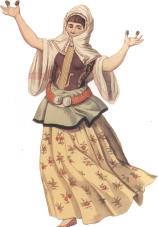Zills and Similar Percussive Instruments
Finger cymbals, or Zills as they are often called are a fairly ancient and common instrument in many countries especially in the Middle East, North Africa, Mediterranean, and South West Asia. Percussive hand held instruments such as cymbals and clappers have been apart of music and dance traditions in this area of the world for thousands of years dating back to ancient Mesopotamia and Egypt. They have often been linked with religious importance in ancient cultures as well as dance practices (possibly indicating links at some point with dance as a religious ritual).
These hand held percussives come in a variety of styles and shapes and can vary greatly in their tonal qualities and resonance. In India they are known as Manjira (मंजीरा). Manjira are fairly large and usually about the size of the players palm. They are connected by a single long cord and are generally held one in each hand where they are then struck together. Some times they are swung around the body to stirike other manjira that have been tied to strategic striking places. In Turkish they are called zils which is where the popular name of Zill originates in Western usage. It is a general term meaning simply cymbal so a zil can be found in a variety of sizes from large marching band striking cymbals to smaller finger cymbals. Larger sets of course are sold as sets of two so that there is one for each hand where as sets that are palm sized or smaller generally come in sets of four so that they can be paired on each hand. Usually being held on the middle finger and thumb but occasionally the player chooses to wear them on the thumb and index finger. Turkish zils tend to produce a higher pitched bell like tone. Larger ones generally have a single hole while smaller ones like those used in dance may have two slots but traditionally also had a single hole. In Egypt they are called sagat (صاجات) and in some surrounding countries they may refer to them as sajat or sanouj. Authentic Sagat will have only one hole and require a special technique to hold and play. Some describe the hold as crab-like because one of the cymbals must be held in place by pressing it against the palm while the other finger moves to strike the pattern. This is different from the type of cymbal many dancers use with two slots. This allows the cymbal to be held more stable and allows for both the thumb and finger to move freely and independently together to produce an unhindered resonating tone. The Sagat on the other hand rolls around on the finger if not held properly and creates a more muted tone sometimes equated as being "clanky." Some parts of the Middle East and the Persians use the term sanj (سنج) this refers to larger cymbals as well as finger cymbals. The Greeks call them Kymbala (κύμβαλο).
In addition to the popular metal cymbals there are a variety of other "clappers" still in use. The modern Spanish Castanets developed in Al-Andalus where native Spanish music and dance met with Moorish, Arab, and later Romani styles to create Flamenco music and dance. These are still a major component of Flamenco and a popular instrument. The technique for playing them is different than a finger cymbal in that they are like two handle-less spoons which are strung together at the base and tied around the thumb. The natural tension holds the two halves open. Cradled in the palm the player can then use their fingers to snap the castanets together and they spring back from the natural tension created by wrapping around the thumb. In other areas like Greece and Turkey dancers use decorative spoons in their dances to create rhythmic accompaniment. The Turkish call them Kasik (kaşık) while the Greeks call them Koutalakia (κουταλακια).
To read more about Middle Eastern Finger Cymbals and clappers please visit these additional pages on this site.
 Learn about the history and development of Zills and other forms of clappers as well as information on their
Learn about the history and development of Zills and other forms of clappers as well as information on their
 construction, differences, buying tips and more.
construction, differences, buying tips and more.
 Learn how to take care of your Zills. Tips for adjusting, securing, placement, maintaining, and cleaning your zills and
Learn how to take care of your Zills. Tips for adjusting, securing, placement, maintaining, and cleaning your zills and
 other hand held clappers.
other hand held clappers.
 Learn how to play your Zills and discover the variety of rhythms/patterns and sounds you can produce.
Learn how to play your Zills and discover the variety of rhythms/patterns and sounds you can produce.


